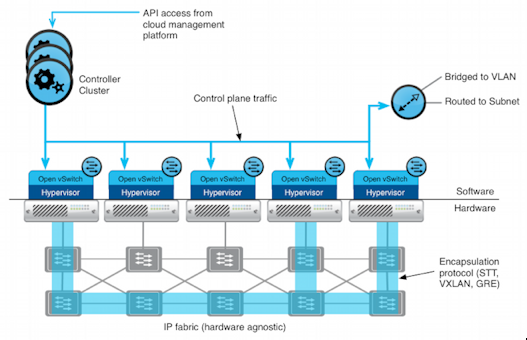High-Level Architecture, Part 1
This blog post will start a series of posts describing my endeavor to gain more knowledge about Network Sky X (NSX). If anyone knows what NSX really stands for, post a comment. NSX, in my opinion, is great component of the Software Defined Data Center (SDDC). VMware has formally asked the vExpert Community to start blogging more about the NSX platform. So I am going to start with the basics: how it works, how to configure it, etc. In this first post, I will start with a high-level description of the NSX architecture. I will get more in-depth in future posts.
This is the best graphically illustrates of the NSX architecture that I could find:
Here are the key components of the NSX architecture:
-
NSX Manager – The NSX manager is the management appliance that helps configure logical switches and connect virtual machines to these logical switches. It also provides the management UI and entry point for API for NSX, which helps automate deployment and management of the logical networks through a Cloud management platform.
-
Controller Cluster – The Controller cluster is the control component that is responsible in managing the switching and routing modules in the hypervisors. The controller cluster consists of controller nodes that manage specific logical switches.
-
VXLAN Primer – Devices connected to logical networks can leverage the entire set of network functions independently from how the underline physical infrastructure is configured.
-
NSX Edge Services Gateway – The NSX Edge can really be considered a sort of “swiss army knife”, because of the multiple services it can provide to the NSX architecture.
-
Transport Zone – In the simplest sense, a Transport Zone defines a collection of ESXi hosts that can communicate with each other across a physical network infrastructure.
-
NSX Distributed Firewall – The NSX DFW provides L2-L4 stateful firewall services to any workload in the NSX environment. DFW runs in the kernel space and as such performs near line rate network traffic protection.
OK now that we have a high level architecture for NSX. Here is my overview on how I see this series unfolding.
- In the next couple posts I will being install the NSX Manager and integrate into vCenter. I will attempt to dive deeper into the NSX architecture.
- Deploy the NSX Controller. The NSX controller is a user space VM that is deployed by the NSX manager.
- Prepare the Cluster(s) for NSX.
- Configuring VXLAN on the vSphere Hosts.
- Create Transport Zones
- Create a logical switch. We will examine the logical network and see how it interacts with the underlying physical network.
I believe these topics looks are the basics. I am sure I will add more to this series as I get going. If there are any topics you want me to tackle, feel free to leave a comment.
I am very excited that I am finally making the time to learn NSX. I hope you are ready for a ride. Let’s get started!
